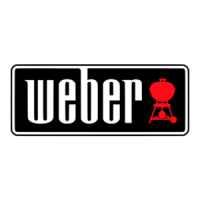4
GETTING STARTED
m DANGER: Do not use a flame to check for gas
leaks. Besure there are no sparks or open
flames in the area while you check for leaks.
m DANGER: Leaking gas may cause a fire or explo-
sion.
m DANGER: Do not operate the grill if there is a gas
leak present.
m DANGER: If you see, smell, or hear the hiss of gas
escaping from the liquid propane tank:
1) Move away from liquid propane tank.
2) Do not attempt to correct the problem
yourself.
3) Call your fire department.
m DANGER: Always close the tank valve before
disconnecting the regulator. Do not attempt to
disconnect the gas regulator and hose assembly
or any gas fitting while this grill is in operation.
m DANGER: Do not store a spare LP tank under or
near this grill. Never fill the tank beyond 80% full.
Failure to follow these statements exactly may
result in a fire causing death or serious injury.
m WARNING: If the hose is found to be damaged in
any way, do not use the grill. Replace using only
WEBER authorized replacement hose.
B
C
LeakChecking
What is a Leak Check?
Once the LP tank is properly installed, it is necessary
to perform a leak check. A leak check is a reliable way
to verify that gas is not escaping after you connect the
tank. The fuel system in your grill features factory-made
connections that have been thoroughly checked for gas
leaks and the burners have been flame-tested.
WEBER recommends performing a thorough leak check
after assembly, as well as annually. The following fittings
should be tested:
• Where the regulator connects to the tank.
• Where the gas hose connects to the bulkhead.
• Where the bulkhead connects to the corrugated gas line.
Checking for Gas Leaks
1) Wet fittings (A) with a soap and water solution, using
a spray bottle, brush, or rag. You can make your own
soap and water solution by mixing 20% liquid soap with
80% water; or, you can purchase leak check solution in
the plumbing section of any hardware store.
2) Slowly open gas supply by turning tank valve
counterclockwise while checking for bubbles.
3) If bubbles appear there is a leak:
a) If the leak is at the cylinder (B), turn o the gas.
DONOT OPERATE THE GRILL. Disconnect the tank
and return the tank to your local retailer.
b) If the leak is at the regulator (C), turn o the gas
(D). NEVER ATTEMPT TO TIGHTEN THE REGULATOR
WITH TANK VALVE OPEN. DO NOT OPERATE THE
GRILL. Contact the Customer Service Representative
in your area using the contact information on our
website.
c) If the leak is at any fittings indicated in illustration
(D), re-tighten fitting with a wrench and recheck for
leaks with soap and water solution. If leak persists,
turn o the gas. DO NOT OPERATE THE GRILL.
d) If the leak is at any fittings indicated in illustration
(E), turn o the gas. DO NOT OPERATE THE GRILL.
4) If bubbles do not appear, leak checking is complete:
a) Turn the gas supply o at the tank and rinse
connections with water.
NOTE: Since some leak test solutions, including soap and
water, may be slightly corrosive, all connections should be
rinsed with water after checking for leaks.
Additional Leak Check Precautions
The following fittings should be tested for gas leaks each
time a tank is refilled and reinstalled:
• Where the regulator connects to the tank (B) and at the
regulator (C).
Follow the instructions for "Checking for Gas Leaks".
E
D
A
m WARNING: If the hose is found to be damaged in
any way, do not use the grill. Replace using only
WEBER authorized replacement hose.

